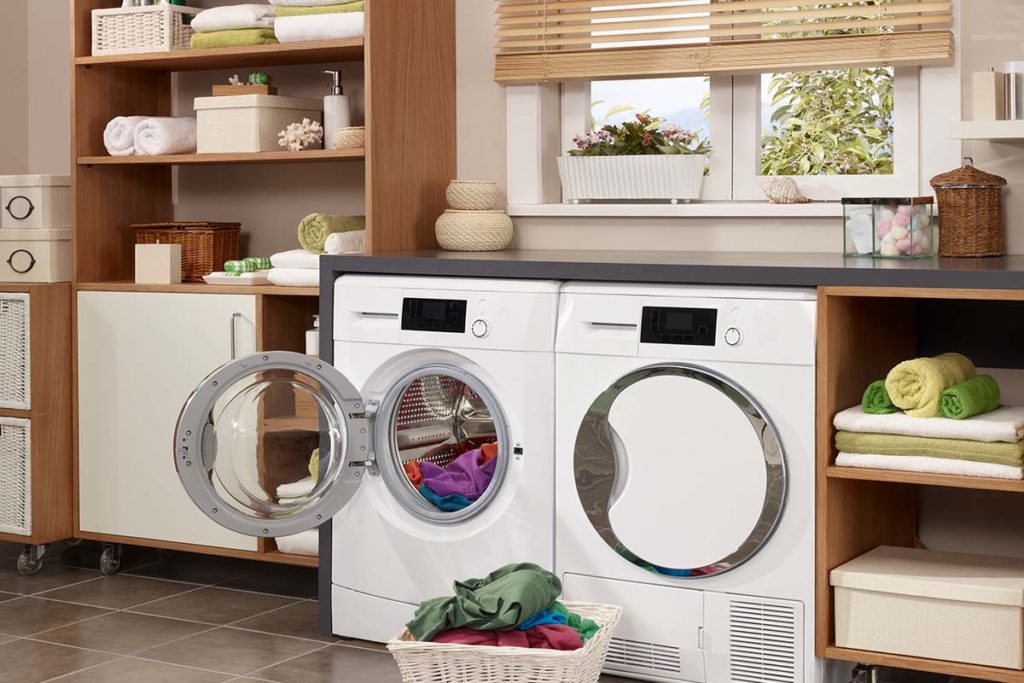Creating an accessible laundry room is no simple matter. Not only do you have to accommodate many different types of equipment, but the room itself needs to be in a convenient location and properly organized. You must keep all of these factors in mind when building a new laundry room or remodeling an old one. The following tips provide a comprehensive guide to laundry room design, and will allow you to continue taking care of this essential chore on your own for many years to come.
Not only do you have to accommodate many different types of equipment, but the room itself needs to be in a convenient location and properly organized.
Location
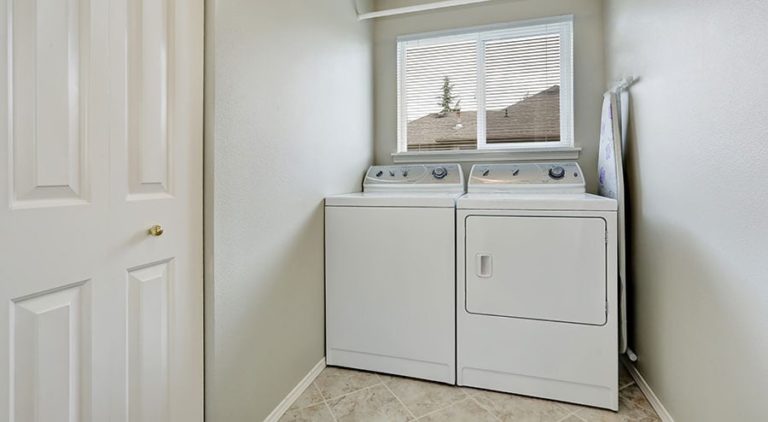
The first step to designing a laundry room for aging in place is to locate the room somewhere you can reach with minimal risk or effort. In general, this should be whatever floor of the house contains your main living area— typically the first floor if you or your loved one has mobility issues. Not only should you try to minimize how frequently you travel up or down stairs in general, but traveling to another floor is especially risky while carrying a large load of laundry. And so you should locate the laundry room on the same level as your bedroom, main bathroom, workout area, and any other location where you might generate dirty clothes. If some of these locations are on different levels of your house, place the laundry room closest to the one that will generate the most dirty clothes— typically the bedroom.
In addition to choosing the right level of your house for a laundry room, you also have to make sure that the specific location on that level is easily accessible. Avoid any rooms that you’ll have to navigate obstacles to access, as these will make you more likely to trip, fall, or injure yourself in some other way while carrying the laundry. Rooms that you can only access through your kitchen, for example, are a poor choice for laundry equipment, since you will have to navigate counters, tables, cabinets, and other obstructions.
Likewise, don’t put laundry facilities in any place where the amount and location of obstacles are likely to change on a regular basis. Even if you have a clear, accessible area in your garage, for instance, garage space tends to fill up without warning. These are even more dangerous than permanent obstacles, since you may not be expecting them if they’re not always there. Instead, choose a room that you can consistently access without any obstructions.
Selecting a Washer & Dryer
The next step is to find appliances that will minimize the effort needed to do laundry. In general, the best washer/dryer combinations allow both machines to be loaded from the front. This will prevent you from having to lift laundry from the washer and then lower it into the dryer, a process that can strain your back or throw off your balance.
Even if your eyesight is good, you should be prepared for the possibility that it will get worse over time, and laundry can be a hazardous task if you have trouble seeing.
At the same time, however, front-loading appliances may make the loading area too low, forcing you to bend over. This can be a hazard if you have back or neck issues. Consider purchasing dryers and washing machines that have pedestals raising them between 10 and 15 inches above the floor. Raising the machines will also allow you to clean the floor without moving them, eliminating another source of hazard and exertion.
Besides the position of the door and the height of the machines, look for appliances with controls that are easy to read. Even if your eyesight is good, you should be prepared for the possibility that it will get worse over time, and laundry can be a hazardous task if you have trouble seeing. If you fail to set your dryer correctly, you could leave clothes in too long or at too high a temperature, raising the risk of fire. Washing is not as dangerous, but you could still very well damage your clothes or waste energy if you choose the wrong setting. You should therefore purchase a dryer and a washing machine with controls that are clearly marked using large, distinct letters. If the paint on the markings ever starts to fade or chip away, touch it up as soon as you can.
The displays and controls in modern laundry appliances are often computerized. While these provide a greater level of detail than traditional technology, they can create unique issues, especially if you have vision problems. When purchasing this type of equipment, make sure that the screens can display messages in large, clear letters, and set them up to use such letters. If possible, find equipment that supplements visual messages with audible instructions. You should also make sure that the screen is as bright as possible in order to reduce the strain on your eyes. You may be able to find a screen that adjusts its brightness in tandem with the lighting in the room.
Finally, some newer washing machines can automatically determine the water level, cycle time, and other features. This requires less input from you, making the machines easier to use if you suffer cognitive, vision, or mobility issues—and makes the machines more convenient in general.
Laundry Room Layout
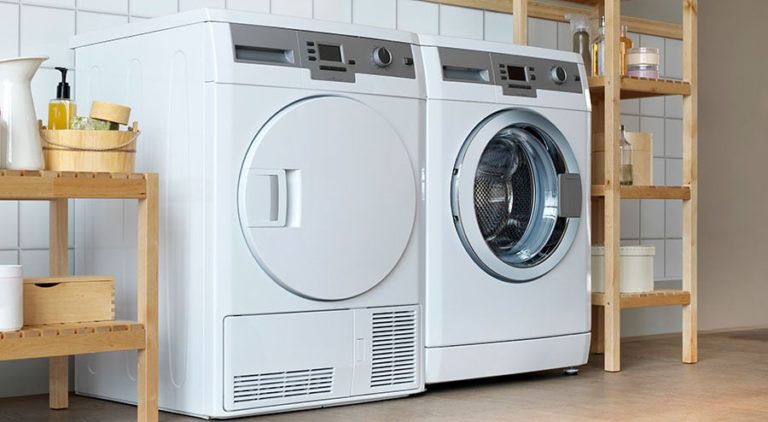
Having chosen the room and selected your appliances, you can now move on to organizing the laundry room space. As with room selection, your goal should be to maximize the amount of free space and minimize the number of hazards and obstacles. This will make laundry both safer and easier.
Ideally, you should be able to see everything in the laundry room when you walk in.
As a first step, place the washing machine and dryer against the wall and out of the path from the doorway. Choose a location that is directly underneath or next to the main cabinets; if you do not yet have cabinets, mark the area where you plan to put them. This way, you will not have to move across the room to get detergent and other essential items, minimizing the effort it takes to do laundry.
Once you have positioned the washing machine and dryer, place any other large items along the wall in close proximity to the appliance you will use them with. If you keep a hamper for dirty clothes, for example, it should be next to the washing machine, as you will likely unload items directly into the machine. Likewise, an ironing board should be next to the dryer, since you will probably iron clothes right as you remove them.
By placing all of these items along the wall, you will keep the interior free of obstacles, making it easier to move inside your laundry room. If possible, you should also keep large items away from the parts of the wall that are closest to the door. Ideally, you should be able to see everything in the laundry room when you walk in. This will reduce the chances that you will bump into or trip over anything when you are doing laundry.
Setting up Your Outlets
Your appliances require electricity, and so will accessories like irons, fans, and dehumidifiers. For this reason, it’s essential to make sure your laundry room is properly wired. You will need:
- A 20-amp, 120-volt circuit for your washing machine.
- A specialized outlet and circuit (dual 120- and 240-volt) for the dryer, which should come with a four-pronged electric plug.
- A 15-amp circuit for lighting, fans, and similar devices
An outlet mounted higher on the wall could be useful for plugging in irons.
While proper wiring is important in any room, it is particularly crucial in laundry rooms given the large amounts of energy they require. As you age, mobility issues may make it harder to respond in time to electrical emergencies. Your best bet is to prevent emergencies from arising in the first place by installing proper wiring.
You should also give some thought to the locations of your outlets: an outlet mounted higher on the wall could be useful for plugging in irons and other items you’ll be using while you work at counter height, while standard baseboard outlets will be needed for other accessories.
Flooring Options for the Laundry Room
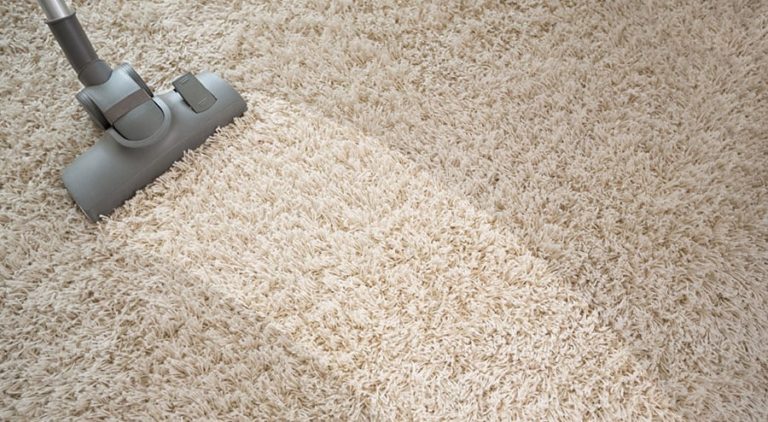
As you plan the layout of your laundry room, you should also consider the type of flooring that will facilitate aging in place. If you opt for a tile or hardwood floor, you may increase your risk of slipping or falling while doing laundry. You may want to replace or cover the material with something less hazardous, such as the following flooring options:
Whatever floor covering you choose, be careful about adding mats or throw rugs, as these are significant tripping hazards.
- Carpet– One of the most common flooring types for laundry rooms, carpet provides traction to prevent you from slipping. If you do
fall, it will cushion you, lowering the risk of injury. Carpet does take more effort to keep clean and dry, however, and it may harbor particulates that will trigger your allergies or harm air quality. Carpet can also present a trip hazard if it gets torn. - Bamboo or Cork– Though not quite as soft as carpeting, these materials do provide a fair amount of traction and cushioning and are less likely to hold particulates. They do, however, absorb water rapidly unless they are sealed. They are also vulnerable to scratching and scoring, making them hard to maintain over the long run.
- Rubber– Rubber floors do not become slippery when wet, are easy on your feet, and will provide cushioning if you fall. They are
more expensive than most other forms of flooring. Because they are easy to maintain, however, you may still end up spending less on rubber floors than on other materials over the long run. - Vinyl– Like rubber, vinyl is easy to clean and maintain, in part because it resists scrapes and scratches so effectively. Non-slip vinyl will also minimize your risk of accidents. But vinyl does not provide much of a cushion, so you are more likely to be injured if you do fall.
Whatever floor covering you choose, be careful about adding mats or throw rugs, as these are significant tripping hazards. If you do use them, tape them securely in place to lower the risk you will slip on them.
Finally, aging in place always requires taking thought for the future. When selecting a material, remember that you may have to use a crutch or walker on it at some point. Make sure to take this into account, along with your budget, health needs, and specific mobility issues, before installing a new laundry room floor.
Supplying Adequate Lighting
Quality lighting is essential for both convenience and safety in any part of your home, and the laundry room is no exception. When setting up the room, you must make sure that lighting is both abundant and and easy to activate.
Besides electric lights, include at least one window in the laundry room if at all possible.
The first step is to decide whether to install lights on the ceiling or simply set up lamps around the room. Unlike lamps, ceiling lights will not take up floor space, leaving you more room to move around and reducing your chance of bumping into something. If you need to change a light bulb, however, it will be much easier and safer to do so with a lamp. But you can keep the number of bulbs you need to change to a minimum by using LED lights, which last longer and consume less energy than traditional incandescent bulbs.
Once you have the lights set up, you should install light switches that are easy to turn on and off. The best way to do this is to use touch or rocking switches, as you can use them even if you develop arthritis or other issues that affect your hands. Install these switches between two and three feet from the ground so that you will not have to reach to use them. If you have lamps, you may also use step switches on the ground, though be careful not to place the wires anywhere where you would be likely to trip on them.
Besides electric lights, include at least one window in the laundry room if at all possible. Natural lighting is good for both physical and mental health, and will help you to enjoy yourself while doing laundry. Having a source of natural light will also allow you to do laundry during the day if the electric lights stop working for any reason.
Placing Your Sink
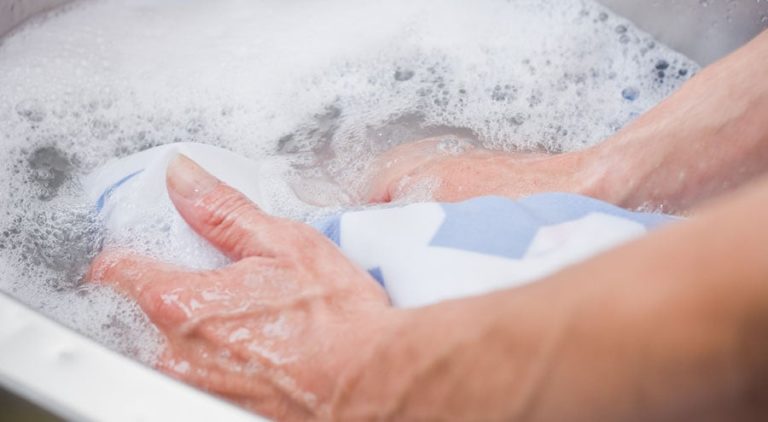
While not essential, a laundry room sink can significantly improve the washing process, especially if you have clothes or linens that need to be cleaned by hand. As long as you have enough space to do so without crowding the room, installing a sink is a good investment.
Install a faucet with a motion sensor which turns the water on when there is something under the faucet and off when that item is removed. While this may be more expensive, it will prevent you from leaving the water running by accident.
Your first priority should be to make sure that the sink is easy to use. The faucet should have lever handles that can be moved with minimal force; this ensures that you can turn the water on and off even if you develop trouble moving your fingers. If the fixtures ever become hard to move, repair or replace them promptly. Alternatively, you can install a faucet with a motion sensor which turns the water on when there is something under the faucet and off when that item is removed. While this may be more expensive, it will prevent you from leaving the water running by accident.
If you have enough space, install a sink with a large basin. This will give you more room to wash multiple items, making for a more convenient experience. It also helps you keep the sink clean, since debris and grime are less likely to become concentrated in small corners.
As with other features of the laundry room, it’s best to plan for future mobility issues ahead of time when installing a sink. If possible, choose a unit that is either mounted against the wall with open space underneath or that provides roll-under room. This way, if you ever have to use a power chair or wheelchair, you won’t have any trouble getting to the sink. As far as height is concerned, make sure that the sink is low enough that you will be able to reach it from a wheelchair, but not so low that you have to bend uncomfortably while standing up.
Setting up Counters and Other Work Spaces
Think about including counters in your laundry room as you plan to age in place. Especially if you have mobility issues or are worried about developing them, a sturdy counter space can give you a surface on which to fold clothes, rest detergent and other items, and iron clothing. Choosing the right kind of counter in the right position can make working in the laundry significantly safer and easier.
It’s important to make sure that your counter does not block the doorway or your path to the washing machine and dryer.
As with other parts of the laundry room setup process, it’s important to make sure that your counter does not block the doorway or your path to the washing machine and dryer. Instead, place it somewhere against the wall away from the door but close to the dryer. This will allow you to move dry clothes onto it for folding or ironing with ease.
Even if it does not block your path, a counter can present a hazard if you bump into it or fall against it. To keep this risk to a minimum, consider installing a soft material on the surface. As with carpeting, you will have to keep this material clean so that it does not harbor allergens. But this should be relatively easy to do if the counter comes up to chest level.
If you have, or are at risk of developing, vision problems, it is important to distinguish the counter from the rest of the room so that you don’t bump into it. If possible, choose a counter that is a different color from that of the wall, floor, and appliances. If it is the same color, place accented stripes on the edges to make it clear where it starts and ends.
Adding Cabinets
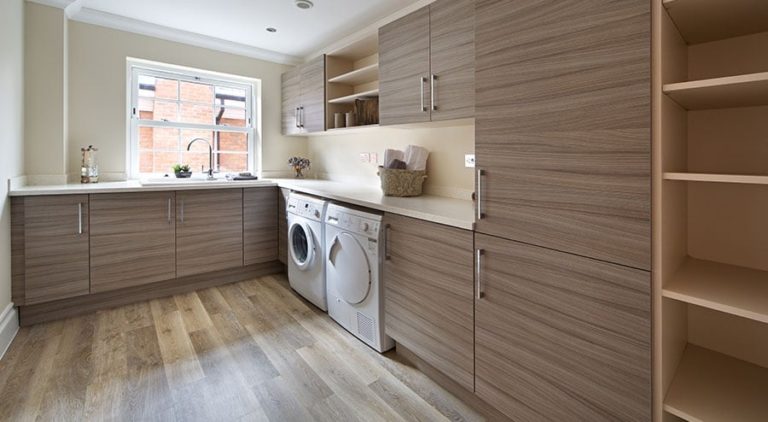
Convenient access to essential laundry items is every bit as important as access to the laundry room. The easier it is to take out and put back detergent, fabric softener, and other items, the less strain and fewer hazards you will face while doing laundry. Cabinets are among the most common and most effective ways to store these items.
Besides the location, make sure the cabinets are designed in a safe, accessible way.
In most laundry rooms, cabinets are directly above the washer and dryer, but it is also possible to place them between the two. Each choice has its advantages and disadvantages, such as:
- Safety Concerns– If you place the cabinets above your cleaning appliances, there is a greater risk that you could spill something while taking it out or putting it back. Spills are less likely if the cabinets are closer to the ground, and if they do happen, you’re less likely to get whatever you’re spilling in your eyes or mouth.
- Efficiency Issues– Placing cabinets above the appliances allows you to use the wall space, which would likely go empty otherwise. On the other hand, if you place the cabinets between the washer and dryer, you will take up more room on the ground, crowding the room and giving you less space to move around.
- Separate Sources of Strain– If you place cabinets above the appliances, you may strain yourself reaching to open them. Instead, store whatever you plan to use frequently on the lowest shelves, reserving higher ones for items you rarely need. With lower cabinets, however, you may hurt your back bending down to them. Make sure to store essential items in the highest shelves of these cabinets.
Besides the location, make sure the cabinets are designed in a safe, accessible way. Opt for D handles rather than knobs, as these will be easier to open if you develop issues like arthritis. Make sure all bottles stored inside are fully sealed to prevent spills. And regardless of where the cabinets are, place items toward the back of shelves when you store them. This reduces the danger that they will fall out when you open the area.
Additional Storage
As valuable as cabinets are for laundry room storage, they are not suitable for all items, and may not be able to hold everything. Consider using these additional forms of storage:
- Collapsible Shelves– One way to use excess wall space effectively is to install collapsible shelves. While you should not use them for permanent storage, they can provide a temporary home for detergent, irons, and other equipment while you are in the middle of doing laundry. Just make sure to collapse them once you are finished using them; if you leave them up, you risk bumping into them the next time you enter the laundry room.
- Roll-Out Shelves– If you have a counter or table in the laundry room, consider putting roll-out shelves under that surface. Not only does this help you maximize your use of space, but if you fill the shelves with items you will use on that surface, the entire laundry room will be more convenient and accessible. Such shelves are particularly valuable for small but heavy objects which might present a hazard if stored in overhead cabinets.
- Lazy Susans– another option for under-the-counter storage is putting a lazy susan underneath your table or counter. This is ideal for storing items that are too tall to fit into roll-out shelves but that you will need to access quickly.
- Bins– For large, heavy items that would not fit in most cabinets and shelves, consider using storage bins, which you can place against the wall. Bins keep these items safe from any moisture or debris on the floor, and can be moved around the room as needed. You can also sit on them or use them as a temporary work surface. If you use multiple bins, you can stack them, but be careful about piling heavy items; the strain of removing one from the stack may be dangerous, and if they tip over, they may create a falling hazard.
As with cabinets, opt for D handles on any shelves or doors you install. For bins, make sure the tops close tightly but can be opened with minimal effort.
Making Ironing Safer and Easier
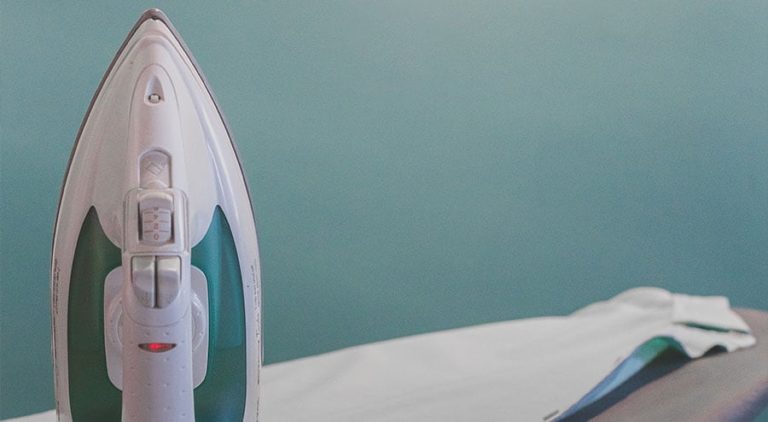
For many seniors looking to age in place, ironing presents a unique challenge. Traditional ironing boards are heavy and difficult to set up. They can become virtually impossible to operate if you develop mobility issues, contract arthritis, or simply lose some of your strength. If you’re committed to keeping your clothes straight, you have to take special precautions to do so safely.
One of the simplest ways to make ironing easier is to install a board that folds down from the wall.
One of the simplest ways to make ironing easier is to install a board that folds down from the wall. Your strength and mobility will not matter, since gravity will do most of the work bringing the board down. As long as the board is relatively light, it shouldn’t be hard to put it back up when you are finished ironing. If possible, position the board close enough to the dryer that you can easily move clothes from one to the other, but not so close that it blocks your access to the dryer’s door.
While collapsible ironing boards are more convenient, there is a risk that you could injure yourself if one drops down unexpectedly. You can keep this danger to a minimum by placing the board inside of a wall-mounted cabinet and only opening the cabinet from the side. You can also store the iron and other equipment in the cabinet, though you must be sure to place them in secured holds. This is essential to prevent them from falling on you when you open the cabinet.
Besides injury from the ironing board, the iron itself can present a hazard. No matter how careful you are, you could end up leaving it plugged in after you are finished ironing, thereby starting a fire. To prevent this situation from arising, install a light kit with a timer on the outlet where you will be plugging the iron in. You can program this to stop the flow of electricity automatically after a certain amount of time.
Ventilation and Humidity Concerns–Plus Some Tips on Air Drying
Consider putting a ceiling fan in your laundry room. A fan provides a number of key benefits, including:
- Improved Air Quality– If you keep a fan running while doing laundry, you’ll ventilate the room and freshen the air. This is particularly important if you have allergies or other health conditions that poor air quality can exacerbate. Maintaining good air quality is critical as you age.
- Consistent Comfort– A fan will also help you feel more comfortable while doing laundry— no small matter given how long the process can take.
- Drying Efficiency– If you use an overhead frame to air out your clean laundry, running a fan can help it to dry more quickly.
A drying cabinet circulates air over clothes that you hang inside, quickly drying them out while avoiding the rough treatment that dryers provide.
If it isn’t possible to install a ceiling fan, you can opt for a freestanding one instead. As usual, make sure that the fan won’t keep you from moving safely around the laundry room.
In addition to keeping air flowing, it’s important to reduce the amount of humidity in the air. This will further improve air quality, making it particularly wise if you develop any respiratory problems as you age. It is also essential if you hang clean laundry to dry or have a carpeted floor. To reduce humidity, start by making sure that the dryer vents outside of rather than into the laundry room. Then check the pipes running to the washing machine and sink periodically to ensure that they are not leaking. If the level of humidity is still a problem, install a dehumidifier to keep it between 30 and 50 percent.
Whether to save energy or preserve certain types of fabrics, you may also want to hang clothes and linens out to dry rather than use a dryer. As you age, however, it will become increasingly difficult to transport items outside and hang them on a clothesline. There are, however, a number of options for indoor air drying, including:
- Drying Racks– You can wheel a rack to the middle of your laundry room and drape items over it. This is ideal if you plan to use the dryer for most of your clothes and linens, but have a few items that have to be air-dried. Just make sure to place the rack against the wall when not in use so that it does not become an obstacle.
- Overhead Clotheslines– You can install a frame clothesline above the washer and transfer clothes directly to it once they are clean. This provides plenty of room to hang large numbers of clothes without blocking the space to move around. It does, however, require you to reach above your head, which could strain you.
- Drying Cabinets– A drying cabinet circulates air over clothes that you hang inside, quickly drying them out while avoiding the rough treatment that dryers provide.
How you choose to air out your laundry is your choice. But by supplementing your dryer with one of these devices, you give yourself greater flexibility to safely and sustainably dry a wide range of items.
Even Your Hamper Deserves Some Attention
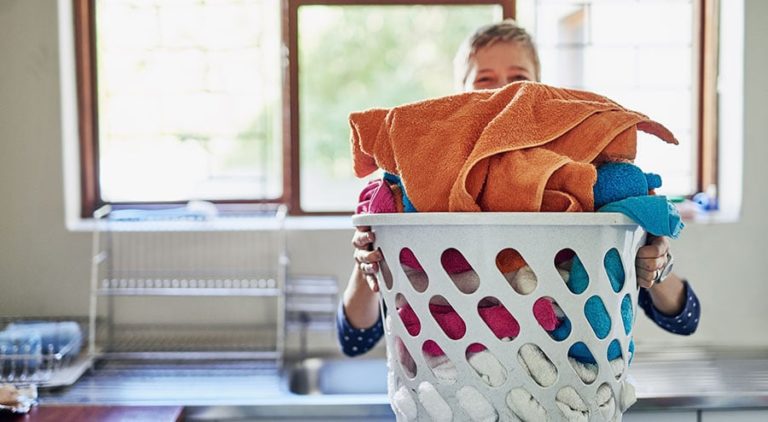
When designing a laundry room, most people give little thought to the hamper, yet it is one of the most important features for saving effort and improving convenience. By choosing the right hamper, you can make laundry easy regardless of any mobility issues that you have or might develop.
By choosing the right hamper, you can make laundry easy regardless of any mobility issues that you have or might develop. A rolling hamper is ideal if you expect to generate laundry from multiple rooms.
It is almost always advisable to get a hamper that has wheels on it. If you can roll it from room to room, you will not have to carry the weight of laundry on your own. This will reduce the amount of effort it takes to do laundry while protecting you from potential sources of strain. A rolling hamper is especially ideal if you expect to generate laundry from multiple rooms. If your bedroom, bathroom, and exercise space are not directly connected to each other, it is far more convenient to be able to wheel the hamper to each location as needed than to keep separate laundry bins in each location. The hamper can also provide some support if the floor ever becomes slippery or you have trouble walking, though it should not be used as a replacement for a walker.
Some Final Tips
Labeling: As you age, there is a good chance that your vision will decline. In order to maintain full use of your laundry room, you should label appliance settings, detergent, and other essential equipment. Describing these items in large, clear letters is a good way to start, but you can also color-code them in case you ever have trouble making out the letters. Another option is to use braille tape. Even if you do not know how to read braille or plan to learn, you can figure out how to recognize the names for simple laundry terms. Ideally, you should use two or more types of labeling to minimize the chance that you will misidentify something.
Disposal: One of the most common sources of hazard in the laundry room is empty bottles. When you have finished using detergent, fabric softener, or—especially— bleach, it’s essential to dispose of these materials in a safe and efficient manner. In particular, you must never reuse these bottles, and you should wash them out before putting them in the recycling bin so you don’t spill harmful chemicals on yourself when taking them out to your bins.
Detergents: In addition to disposing of it properly, it is also important to make sure that your detergent can be administered safely and conveniently. Traditional detergent bottles, which require you to pour the liquid, could get hard to handle if you develop arthritis or mobility issues, and if you spill them, you could slip on the floor and injure yourself. For this reason, you might consider storing detergent in bottles with a nozzle on the bottom, allowing you to easily pour the liquid into a cup. Alternatively, you could use detergent pods, though these tend to be more expensive.
Taking steps right now to address the accessibility and usefulness of your laundry room can help you keep on top of this essential task well into your senior years.
Scheduling: Once you have optimized the convenience and safety of your laundry room, you may be surprised by the next essential step: put your laundry on a schedule. As you age, anosmia or cognitive decline may make it harder to tell when you need to wash your clothes and linens, and dirty laundry may pile up, harming your health and quality of life. You may not have those problems now, but aging in place requires planning for all eventualities. The earlier you develop a laundry routine, the easier it is to keep to it no matter what else happens.
Specific scheduling will vary based on your individual needs. In general, try to do laundry at least once every two weeks. If you pick the same day of the week to do it, you’re more likely to remember it. You can also set digital reminders on your phone and computer and on more advanced laundry machines.
We all want to live independently, regardless of our time of life. And while aging, unfortunately, can impair your ability to live independently, taking some steps right now to address the accessibility and usefulness of your laundry room can help you keep on top of this essential task well into your senior years.
